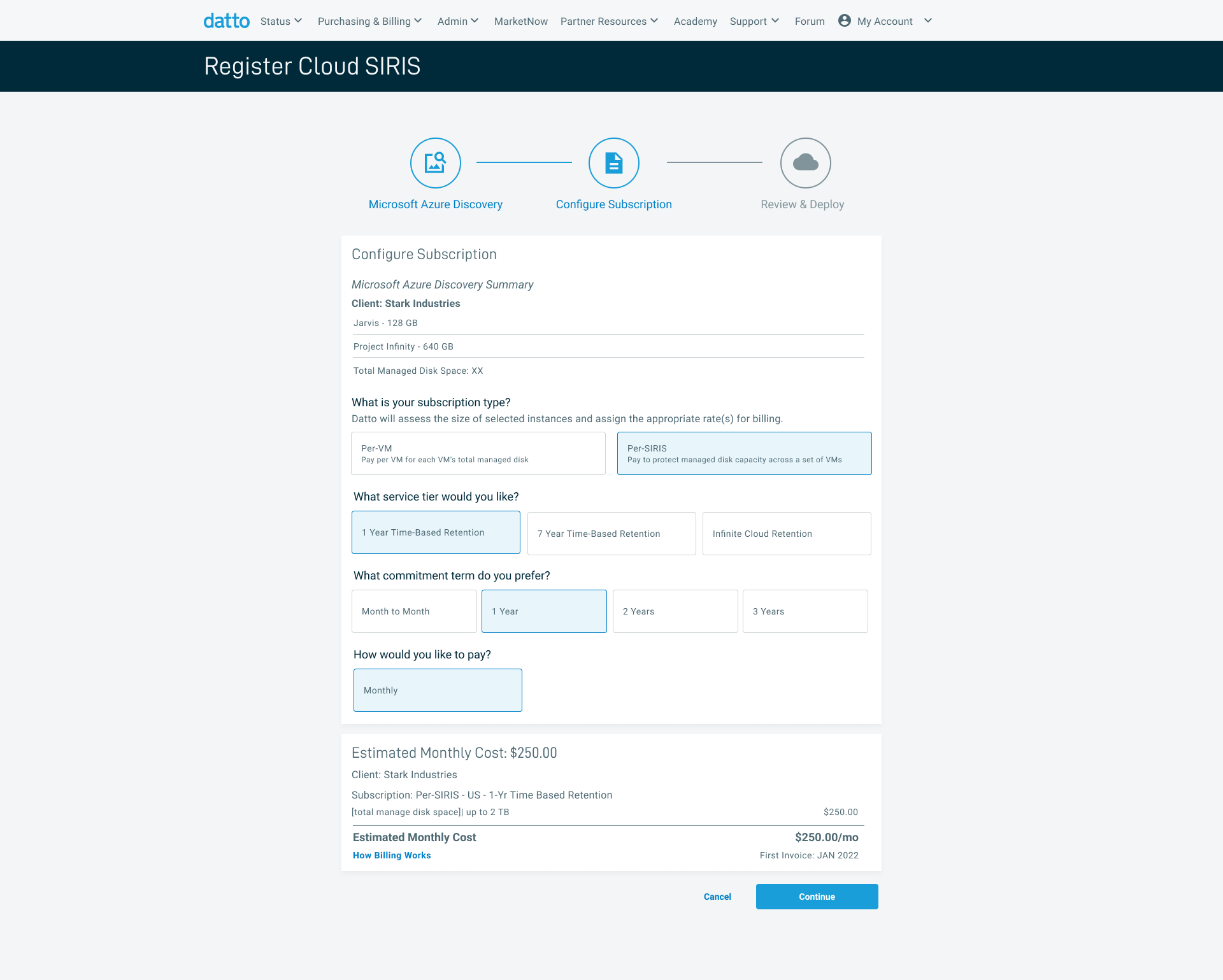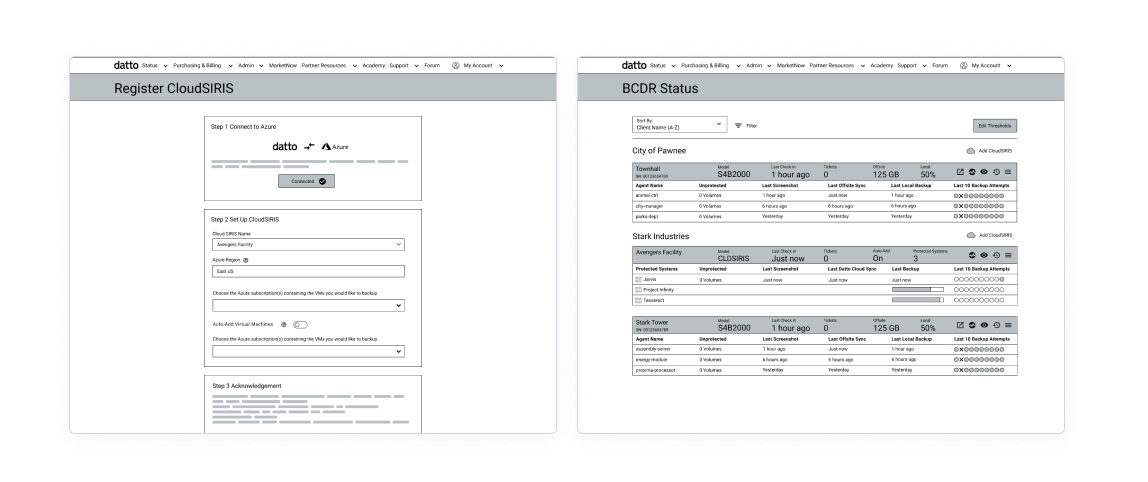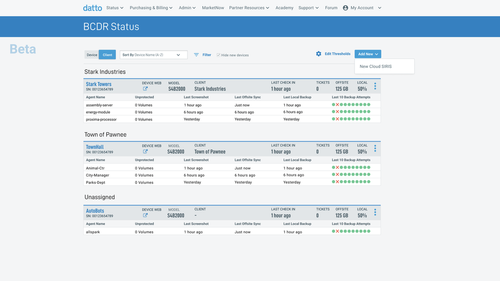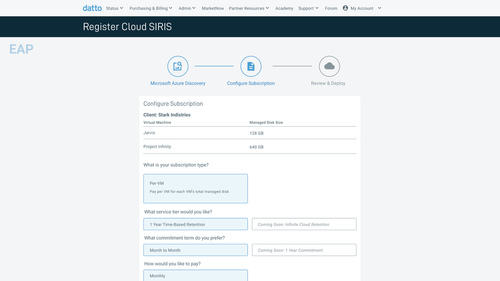Datto Continuity for Microsoft Azure
Product Launch

Datto Continuity for Microsoft Azure
Product Launch
Workloads in Microsoft Azure today can be backed up, but are not fully protected with a business continuity solution, which leaves customers vulnerable to single cloud risk and downtime scenarios such as ransomware and public cloud outages. There is no viable solution for MSPs to offer their clients comprehensive protection of workloads in the public cloud.
Launch a new product that gives MSPs a business continuity solution for Microsoft Azure that is simple to deploy and can be managed in a single-pane-of-glass alongside their on-premise devices.

For a 60-person cross-functional team, I was the sole Product Design and UX resource with manager support.
As the lead product designer for the new product, I was responsible for the concept vision, conducting partner interviews, user acceptance testing, designing and delivering an interactive prototype of the final solution. I worked across the organization with product management, marketing engineering, sales, and tech support.
The key design challenge for this project was to find a strategy for partners to purchase a SaaS Product and deploy it as quickly and simply as possible. We also wanted the management & monitoring experience to be identical to their on-premise devices, to provide them with a single-pane-of-glass for their hybrid fleet.
We conducted Voice of Customer interviews during the project's discovery phase, in collaboration with product management and product marketing. We needed to know what their existing backup solution was missing, what type of environments they wanted to protect as well as how they would roll out this product to their clients


At the start of the design process, I developed low-fidelity wireframes to represent our vision for the product we want to launch. This included a three-step purchasing flow and a status page that encompassed three Datto Product lines. Following that, we reduced the number of features and broke them into phased programmed releases; Alpha, Beta, and Early Adopters Program (EAP).
Each phase built upon the existing features of the one before, improving based on user feedback and engineering capabilities.

Minimal viable product. No concept of purchasing, the goal was to get a feel for connecting to the Azure Environment and deploying the CloudSIRIS
Cloud SIRIS Registration
Auto-discovery and selection of VMs to protect via Portal
Agent deployment and pairing via Portal
Cloud SIRIS Device Details

Introducing the concept of purchasing through the status page and minimum size limitations for the environments to be protected
Initial purchasing structure
Client-centric BCDR + Azure Status Page
Backup Progress in Portal
Cloud SIRIS Device Settings
Cancel/Remove Protected Systems
Instant Virtualization in Datto Cloud

An almost ready-to-launch product! A full-fledged purchasing flow has been implemented, increase the size of the environment the CloudSIRIS can protect, with more device capabilities
Full self-service per-VM purchasing
Restore to Azure Enhancements
Restore to Azure from Datto Cloud
Email alerting
For each release of the product, I conducted User Acceptance Testing in order to reveal possible usability problems and address them for the next release.
Purchasing - Prompted users to complete the tasks of registering and deploying a Cloud SIRIS
Monitoring - understand what our users look for first and what is important to them to help them accomplish tasks
Ratings - We asked if it was easy to complete their tasks and if the designs they saw were ready for launch on a scale of 1-7.

Partners agreed that the registration flow was logical, but lacked flexibility as well as clarity surrounding needed permissions.
The Beta version was described as slicker than the Alpha prototype and resembled the purchase procedure of another Datto product, Datto SaaS Protection. Environment protection was deemed to be quite smooth, with new ones being added much more easily than in the previous release.
The registration flow was described as straightforward and can be done without a technical background. The majority of participants said this flow will work for their current purchasing process within their organization. Improvements to the status page like the add new button, progress bar, and grouping by client were all well received. The majority of participants prefer the Standard view over compressed because of the amount of information shown and load time.

Turnkey offering that is easy-to-deploy
Single pane of glass to manage hybrid continuity environments
Same Datto experience they know and trust

Each phase of the Azure project was a constantly developing design problem with ever-changing needs. I had to adapt my solutions to fit each new requirement that arose.
I take in requirements from multiple sources, from PMs to engineers, and our users. It always feels like putting together a puzzle, I had to find the right pieces to meet the business's needs but still be able to put our users first.
“I say this all the time— there would NOT be an Azure Product if it weren’t for Abbey Jo! She is an outstanding colleague who is so talented at summarizing everyone’s input (product, engineering, and partners) and creating a new vision for our products!”
View Next: Unified Continuity